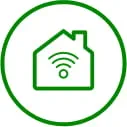As aspects of our lives continue to transition online and we become increasingly digitally connected, the choices we make about our internet can significantly impact our lifestyle. The question of “what internet speed do I REALLY need?” can be difficult to answer.
How do I know what speed I need?
Determining the ideal speed for your home needs hinges on factors like the number of people and devices in your household and your online activities. The era of remote work/education, online entertainment and smart homes has amplified our reliance on the internet. While minimal speeds may suffice for basic browsing, streaming, and emails, a bustling household likely demands more.
Smaller households with minimal internet use can get by on lower speed plans. So, you need to determine how much you use your internet, what speed plan you currently have, and if that current plan supports your needs to your satisfaction.
Internet speed plans, explained
When you’re choosing an internet plan, your internet service provider will have a list of options. The lower end of the speed tier may be around 5 Mbps, while the higher end might be 1 Gbps.
Here are some common activities and the speeds they need according to the number and type of devices you use.
| Speed Range | Devices | Supported Activities |
| 5-25 Mbps | Up to 5 | Basic internet use from casual web browsing to emailing |
| 25-100 Mbps | Up to 10 | Working from home, streaming 4K video, gaming (Ziply Fiber’s lowest speed offer) |
| 100-500 Mbps | Up to 15 | Working and studying from home, gaming, and streaming 4K video all at once |
| 500 Mbps- 1 Gig+ |
Over 15 | Working and studying from home, gaming, streaming 4K video, running all smart home devices simultaneously
|
See: Why is fiber better for gaming?
Now, you may think you don’t need much speed, but consider that the average American household boasts a staggering 25 internet-connected devices, a phenomenon known as the Internet of Things (IoT). This means that your internet connection not only supports your personal devices but also keeps your smart home humming. Twenty-five sounds like a lot, so what do we count as a device? Let’s break these down into some major categories:
Personal devices: computers, laptops, tablets, phones, watches, headphones, etc.
Smart appliances: fridges, robot vacuums, printers, speakers, baby monitors, lights/lamps, etc.
Smart home: hubs (Amazon Echo, Apple HomePod HomeKit, etc.), thermostats, garage doors, etc.
Security systems: doorbells, cameras, locks, alarms, etc.
Gaming devices: Xbox, PlayStation, Nintendo Switch, VR devices, etc.
Streaming devices: Apple TV, Roku, Chromecast, Amazon Fire, etc.
Ultimately, what speed you need depends on what kinds of activities at your home require internet, and how many of these activities are happening simultaneously. If your work is hybrid or remote and involves online meetings or conferences, if you have a large family or many roommates, if you are an avid gamer or online personality, the more speed you’re going to need. Otherwise, you’re going to notice lag, glitches and general slowness.
What speed do I need?
Take a look around your house. Consider what you’re getting from your current connection. Is it sufficient? Does it slow down at certain times, like around 5 pm, or do your streaming services pause to buffer? Do you have way more smart home devices than you realized? Do you have kids or housemates who are increasing their online time with gaming, streaming or online work?
Consider that even if you need a minimal speed, that speed slows down the moment it enters your house, unless you are connecting via an Ethernet cable. Not only that, but if your speeds aren’t symmetrical — if your download speed is faster than your upload speed — you’re going to experience lag. So, you’re better off erring on the side of more speed as opposed to less, especially if your internet needs are more than bare bones.
For the best, fastest experience, switch to fiber-optic internet
For the fastest speeds in the industry that can handle the greatest number of devices with no lag, latency, buffering or glitching, you’ll want to switch to a fiber-optic internet plan. Fiber internet improves upon cable internet in that it utilizes light to transmit data at lightning-fast speeds, creating a more stable and congestion-resistant environment. This also means fiber is capable of unimaginably fast speeds and transporting large loads of information at once.
While both fiber and cable are capable of gig-speed options, the key difference lies in reliability and future-proofing. Fiber-optic networks provide a level of dependability that cable networks struggle to match.
See: What is fiber optic internet?
When it comes to sheer speed and bandwidth, fiber easily takes the crown. Fiber-optic connections can offer speeds far faster than cable's maximum of 1,200 Mbps (or 1.2 Gbps). This discrepancy becomes particularly noticeable when multiple devices vie for bandwidth. Additionally, fiber has symmetrical upload and download speeds. This means that instead of cable’s 5 Mbps upload speeds with much higher download speeds, fiber allows for 1 Gig upload speeds with 1 Gig download speeds. With fiber, you can smoothly juggle gaming, streaming, video conferencing and more without a hitch.
See: What is gig speed?
Preparing for the future
In a world where our reliance on the internet continues to grow, future-proofing your connection becomes paramount as we consider the future demands of our digital lifestyle. Fiber-optic gig-speed plans are not only about satisfying today's demands but also anticipating the ever-evolving digital landscape and securing a connection that keeps up with our lifestyles and aspirations.
Ziply Fiber offers fiber internet plans starting at 100 Mbps all the way up to 10 Gbps. When in doubt, go for our most popular plan, Fiber Gig, which gives you reliable 1 Gig upload and download speeds that meet the needs of the average connected household. Check your address today at ziplyfiber.com to see if we’re in your neighborhood.






